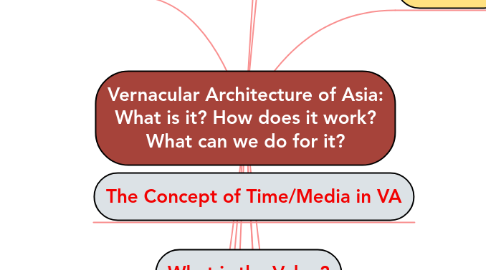
1. How can we face changing?
2. V and Modern
3. What is the Value?
4. The Concept of Time/Media in VA
5. Level of Meaning (Value)
5.1. Low Level
5.2. Middle Level
5.3. High Level
5.4. Indigenous Issue
5.5. Non-space
5.6. Relations between 1 2 3
6. 1. VA as a Continuing Process
6.1. Changing & Adaptation
6.1.1. Response towards Environmental Limits
6.1.2. Authenticity
6.2. Traditional Expertise Engagement
6.2.1. Localized Craftmanship
6.3. Space & Time
6.4. Original: Particular Time, Location & Group of People
7. 2. People, Culture
7.1. Relationship & Media
7.2. Three Levels of Meaning
7.2.1. Low: Everyday need & Instrumental/functional
7.2.2. Middle: Community & Identity & Power, Status, Wealth
7.2.3. High: Cosmos, World, Philosophy, Human - Nature
7.3. Boundry or Relations of Levels Meaning
7.3.1. Changing - Transformation - Vanish
7.3.2. Time
7.3.3. Human Engagement
7.4. Indentity
7.5. T. S. Eliot
7.5.1. Tradition cannot be inherited, and if you want it, you must obtain it by great labour
8. Short Terms
8.1. VA: Vernacular Architecture
8.2. V: Vernacular
9. 3. Climate
9.1. VA as Response & Relfection
9.1.1. Basic Need (Shelter)
9.1.2. Typology in Cifferent Regions
9.1.3. Materiality
9.1.4. Cultural Context
9.1.5. Geographic Conditions
9.1.6. Sharing Forms
9.1.6.1. Japanese Shoji - Paper Windows
9.1.6.1.1. Recycles - Conserve - Relation with Nature
10. 4. Materials, Construction
10.1. Cultural
10.1.1. Globalization - Regionalism
10.1.2. Scales of Design
10.2. Spiritual
10.2.1. Belief of Nature - Communication - Transmigration
10.3. Materiality
10.3.1. Natural or Manufactured? (production process or chemical process)
10.3.2. Bricks - Manufactured
11. HKU ARCH_5107_7161 Vernacular Architecture of Asia
12. Historical View
12.1. What is history?
13. The Meaning of V in Classical Context and Contemporary Context
14. ICOMOS Defination
14.1. http://www.icomos.org/charters/vernacular_e.pdf
15. 5. V Landscapes
15.1. Public - Private (Property)
15.2. Urban - Rural (Context)
15.3. Sense of Place (Intellectual Meaning & Quality)
15.4. Man-made - Natural
15.4.1. Criteria & Transformation (existence)
15.4.2. Natural elements to Farmland or Garden (Non-professional Transformation)
15.4.3. Unit: Single - Group - Community - Society
15.5. Fengshui
15.5.1. Concept of Site Planning, Orientation and Scale
15.6. Time - Space
16. 6. Rural V
16.1. Why do we study Rural V?
16.1.1. Origin
16.2. Vernacular Setting and Its Relationship with Nature
16.3. Ideas for Urban Environment
16.4. Conservation of Traditions
16.4.1. Time
16.4.2. Returned Generations
16.5. Urbanization Forces and Changing
16.5.1. Better Life - Modern Life
16.5.2. Rapid Change - Population
16.5.3. Source of Wealth and Trigger
16.6. Context in Different Countries
16.7. self-conscious or un-
16.7.1. Christopher Alexander (1965) and Amos Rapaport (1969) argues that vernacular built-form is the most obvious and direct means of expression of a people and its culture, without having to go through a self-conscious process of thinking. C. Norberg-Schulz (1975) thinks otherwise. Is the vernacular process a self-conscious or an unself-conscious one?
17. 7. Urban V
17.1. Difference Between Urban & Rural
17.1.1. What is city?
17.2. Colonialism
17.2.1. Culture - Economy & Politics
17.2.2. Building Typology - Localization
17.2.2.1. Materials
17.2.2.2. Climate
17.2.3. Identity
17.2.3.1. Changing - History & Future
17.2.4. Hong Kong Context
17.2.5. Other Asian Country
17.3. Urbanization - Transformation
17.3.1. Rapic Process & Adaptation
17.3.2. Migration from Rural to Urban
17.4. Concentration of Population - Sources
17.4.1. Advantages
17.4.2. Disadbantages
17.5. Communication Way Comparing in Village - Community Life to Numbers
17.6. Trourists
17.6.1. Contributions & Forces
17.6.2. Shop Houses
17.7. City as a Cultural Milieu
17.7.1. Hierachy System
17.7.2. The Reflection of Cultural Diversity
17.7.2.1. People
17.7.3. Three Levels of Meaning
17.7.3.1. The expression of Meaning
17.7.4. Multiple Layers of Culture
17.7.4.1. Representation
17.7.5. Tangible & Intangible
17.7.6. Urban Deversity
18. 8. Informal Settlements
18.1. Formal & Informal
18.1.1. Process - Individual Choice/Development
18.1.2. Desire and Status
18.2. Informal Settlement
18.2.1. Informal Materials
18.2.2. Reason: War, Migration, Rapid Economy Develpment
18.2.3. Life Styles
18.2.4. Social Concerns
18.2.5. Piecemeal Fashion
18.2.6. Problem: Infrastructure, Safety, Health, Education, Property
18.2.7. Community - Business - Respect
18.2.8. Ownership Issue: Renting
18.2.9. Regulation and Legal Control
18.3. Location
18.3.1. Village
18.3.2. Urban Outskirt
18.3.3. Urban Village
18.3.4. Street - Deadend
18.3.5. Rooftop
18.3.6. Boat
18.3.7. River
19. 9. Architectural Conservation of Built V Heritage
19.1. Preservation & Conservation
19.1.1. Differences
19.2. Role of Architecture: As Medium
19.3. Activities and Alternative Activites
19.4. Continuity of Story - Sense and Existence of Place
19.5. Heritage/Relic to Live Place - New Community (Regeneration - Reactivate)
19.6. Multiple Disciplinary Engagement - Public Engagement
19.6.1. Hong Kong Context
19.7. Tangible and Intangible Value - Sustainability
19.8. Architectural/Cultural Value & Economical Value
19.9. Level of Meanings
20. 10. The Future of Asia's VA
20.1. Aspects of Sustainability
20.2. Identity: Single - Local - Regional - National
20.3. Cultural Sustainablity
20.4. Tradition (Process - Production)
20.4.1. on-going
